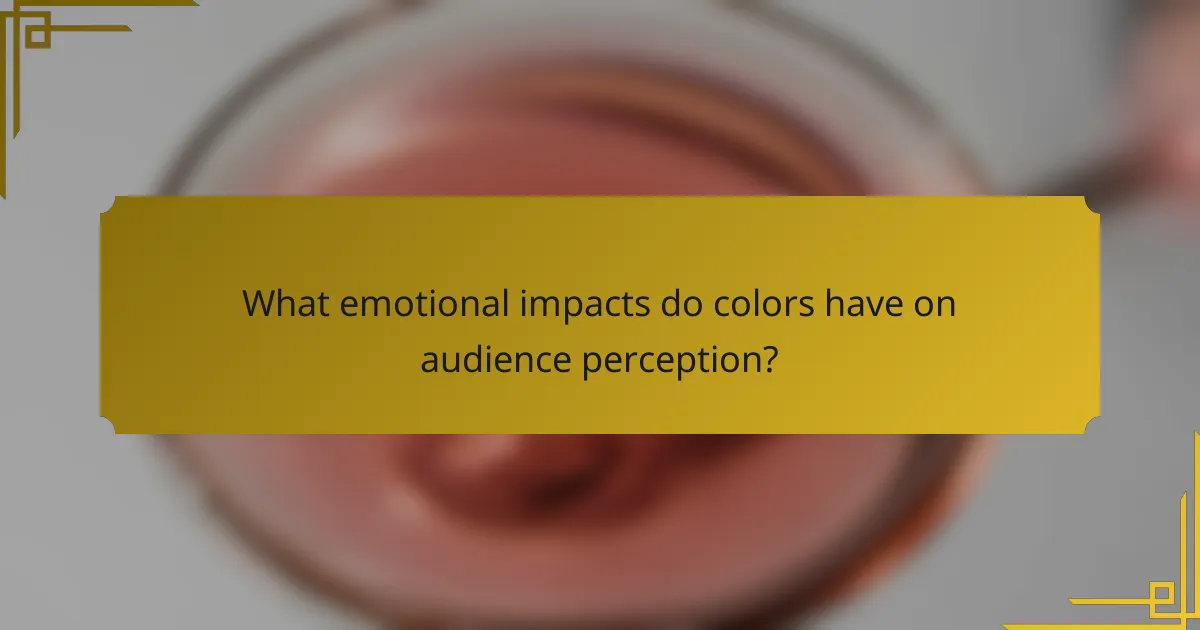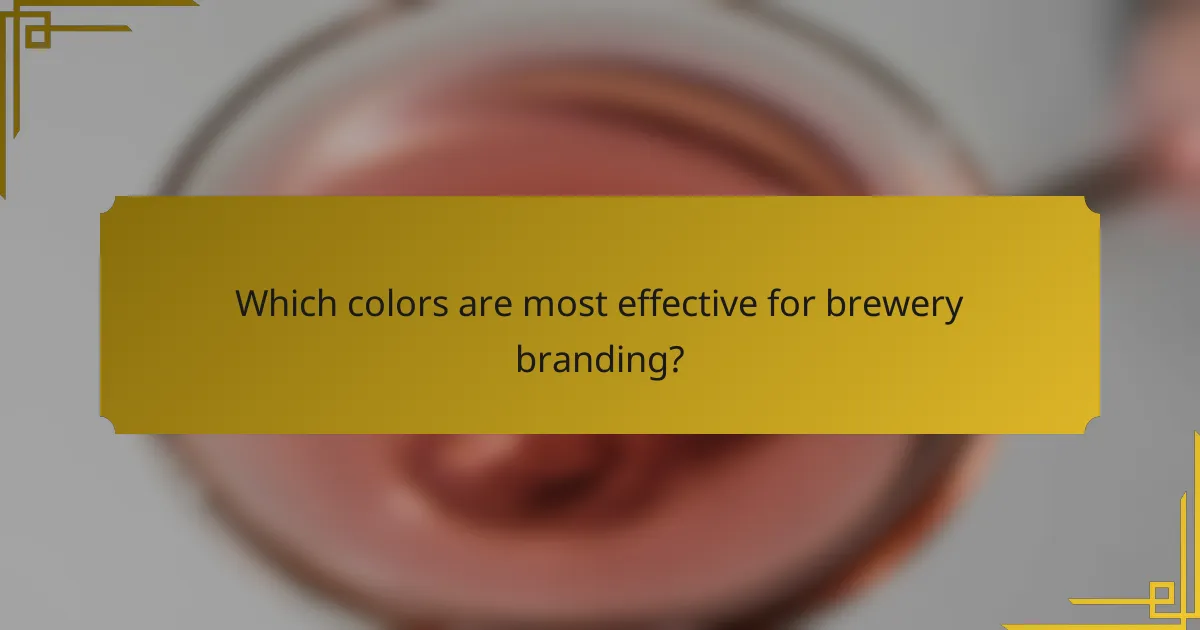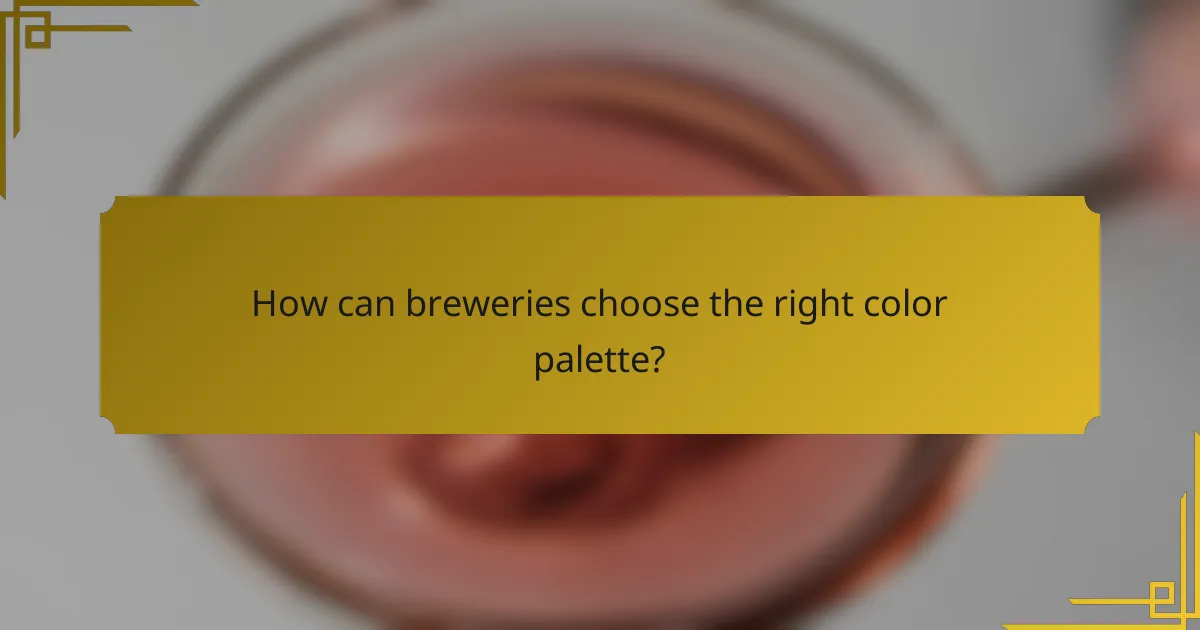In the competitive world of brewery branding, color psychology is essential in shaping consumer perceptions and emotional responses. Strategic color choices not only evoke specific feelings but also influence purchasing decisions and enhance brand recognition, making them a powerful tool in attracting and retaining customers.

How does color psychology influence brewery branding?
Color psychology plays a crucial role in brewery branding by shaping consumer perceptions and emotional responses. The right color choices can evoke specific feelings, influence purchasing decisions, and enhance brand recognition.
Color associations with emotions
Different colors are associated with various emotions that can impact how consumers perceive a brewery’s brand. For instance, blue often conveys trust and reliability, while red can evoke excitement and passion. Understanding these associations helps breweries select colors that align with their brand identity and target audience.
Additionally, warm colors like orange and yellow can create a sense of friendliness and approachability, making them suitable for casual or social brands. In contrast, darker colors such as black or deep green may suggest sophistication and premium quality.
Impact on consumer behavior
Color influences consumer behavior significantly, often affecting their choices at the point of sale. Studies suggest that up to 90% of snap judgments about products can be based on color alone. Thus, breweries that effectively utilize color can enhance their appeal and encourage purchases.
Moreover, consistent use of color across branding elements—like packaging, logos, and marketing materials—can strengthen brand recognition and loyalty. Breweries should consider testing color variations to see which combinations resonate best with their audience.
Case studies from successful breweries
Many successful breweries have harnessed color psychology to enhance their branding. For example, Blue Moon uses a light blue color scheme that reflects its refreshing, approachable image, appealing to a broad audience. This color choice aligns with the brand’s identity as a casual, easy-drinking beer.
Another example is Heineken, which employs a bold green color that signifies freshness and quality. This strategic use of color has helped establish Heineken as a premium beer brand worldwide. Analyzing these cases can provide valuable insights for new breweries looking to create impactful branding strategies.

What emotional impacts do colors have on audience perception?
Colors significantly influence audience perception by evoking specific emotions and associations. For instance, warm colors like red and orange can create feelings of excitement and urgency, while cool colors such as blue and green often convey calmness and trust.
Colors and brand loyalty
Brand loyalty can be heavily influenced by color choices. Brands that consistently use specific colors in their branding can create a strong emotional connection with their audience, leading to increased loyalty. For example, brands like Coca-Cola use red to evoke excitement and passion, which resonates with their consumers.
To enhance brand loyalty, consider aligning your color palette with the emotions you want to evoke. Conducting surveys or focus groups can help determine how your target audience perceives different colors.
Color effects on purchasing decisions
Colors can significantly affect purchasing decisions, with studies suggesting that up to 85% of consumers make buying decisions based on color alone. For example, blue is often associated with trust and reliability, making it a popular choice for financial institutions.
When designing packaging or marketing materials, choose colors that align with the emotions you want to evoke in your audience. Avoid using too many colors, as this can create confusion; instead, stick to a cohesive palette that reflects your brand identity.

Which colors are most effective for brewery branding?
Effective colors for brewery branding can evoke specific emotions and perceptions, influencing customer choices. Colors like amber, green, and deep blue are commonly used, each carrying distinct meanings that resonate with consumers.
Popular color choices in the craft beer industry
In the craft beer industry, popular color choices include amber, gold, and earthy tones. Amber often signifies warmth and richness, appealing to those seeking a traditional experience. Green is frequently associated with freshness and nature, making it a favorite for breweries emphasizing organic or sustainable practices.
Additionally, deep blues and blacks can convey sophistication and quality, attracting a more upscale audience. Bright colors like red and orange can create a sense of excitement and energy, appealing to adventurous drinkers.
Color trends in brewery logos
Current trends in brewery logos often feature minimalist designs with bold color schemes. Many brands are opting for a limited palette to create a strong visual identity, making their logos easily recognizable. This trend aligns with consumer preferences for simplicity and clarity in branding.
Moreover, retro and vintage styles are gaining popularity, with colors that evoke nostalgia. These designs often use muted tones combined with classic typography, appealing to consumers’ emotional connections to tradition and craftsmanship.

How can breweries choose the right color palette?
Breweries can choose the right color palette by understanding the psychological impact of colors and how they resonate with their target audience. Selecting colors that align with the brand’s identity and evoke the desired emotions can significantly enhance customer perception and loyalty.
Guidelines for selecting colors
When selecting colors, breweries should consider their brand personality and the emotions they want to evoke. For instance, earthy tones may convey a sense of tradition and craftsmanship, while vibrant colors can suggest innovation and excitement. It’s essential to create a cohesive palette that reflects the brewery’s mission and values.
Additionally, cultural associations with colors can vary widely. For example, in some cultures, red symbolizes good fortune, while in others, it may represent danger. Conducting audience research can help identify the most effective color choices for a specific market.
Tools for color selection
Several tools can assist breweries in selecting the right color palette. Online platforms like Adobe Color and Coolors allow users to create and experiment with color combinations easily. These tools often provide insights into color harmony and contrast, which are crucial for effective branding.
Another practical approach is to use color psychology guides that outline the emotional responses associated with different colors. This can help breweries make informed decisions based on the feelings they wish to evoke in their customers. Testing color options through surveys or focus groups can also provide valuable feedback before finalizing a palette.

What role does audience perception play in branding?
Audience perception is crucial in branding as it shapes how consumers view and interact with a brand. Positive perceptions can lead to loyalty and increased sales, while negative impressions can deter potential customers.
Understanding target demographics
Identifying target demographics helps breweries tailor their branding strategies effectively. Factors such as age, gender, income level, and lifestyle preferences influence how a brand is perceived. For instance, a craft brewery targeting millennials might use vibrant colors and modern designs, while a traditional brewery may opt for classic, earthy tones to appeal to an older audience.
Conducting market research through surveys or focus groups can provide insights into demographic preferences. This information can guide branding decisions, ensuring that the visual identity resonates with the intended audience.
Consumer feedback and brand image
Consumer feedback is essential for shaping and maintaining a positive brand image. Engaging with customers through social media, reviews, and direct surveys can reveal how the audience perceives the brand’s values and aesthetics. This feedback loop allows breweries to adjust their branding strategies based on consumer preferences and sentiments.
It’s important to actively listen to feedback and respond to concerns or suggestions. Brands that demonstrate responsiveness can enhance their reputation and foster a loyal customer base. Regularly assessing brand image through customer feedback can help breweries stay relevant and appealing in a competitive market.

How can breweries measure the impact of their branding?
Breweries can measure the impact of their branding through various methods that assess audience perception and emotional response. Effective measurement combines qualitative insights from consumer feedback with quantitative data from performance analytics.
Surveys and focus groups
Surveys and focus groups are direct ways to gauge consumer sentiment about a brewery’s branding. Surveys can be distributed online or in-person, asking participants about their perceptions of brand colors, logos, and messaging. Focus groups provide a more in-depth discussion, allowing participants to express their feelings and thoughts about the brand in a collaborative setting.
When conducting surveys, consider including questions that rate brand elements on a scale, such as 1 to 5, to quantify responses. Focus groups should ideally consist of diverse participants to capture a wide range of opinions, which can help identify common themes or surprising insights.
Analytics tools for brand performance
Analytics tools can provide breweries with valuable data on how their branding influences sales and customer engagement. Platforms like Google Analytics can track website traffic and user behavior, while social media analytics can reveal audience interactions with branding elements. These insights help identify which branding strategies resonate most with consumers.
To effectively use analytics, set clear goals for what you want to measure, such as increases in brand awareness or sales growth. Regularly review the data to adjust branding strategies as needed, ensuring they align with consumer preferences and market trends.

What are the best practices for brewery branding?
Effective brewery branding involves creating a cohesive identity that resonates with your target audience. This includes using consistent visual elements, messaging, and emotional triggers that reflect the values and personality of your brewery.
Consistency across marketing channels
Maintaining consistency across all marketing channels is crucial for effective brewery branding. This means using the same color schemes, logos, and messaging whether on social media, packaging, or your website. Consistency helps build brand recognition and trust among consumers.
Consider creating a brand style guide that outlines your visual identity and tone of voice. This guide should be shared with all team members and partners to ensure everyone is on the same page. For example, if your brewery uses earthy tones in its logo, those colors should also appear in promotional materials and merchandise.
Regularly review your marketing materials to ensure they align with your established branding. A common pitfall is allowing different channels to drift apart in style or messaging, which can confuse potential customers. Aim for a unified look and feel that clearly communicates your brewery’s unique story and values.
